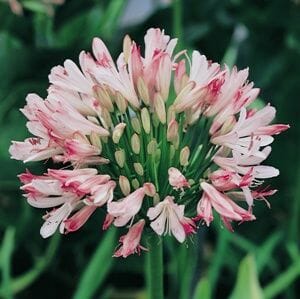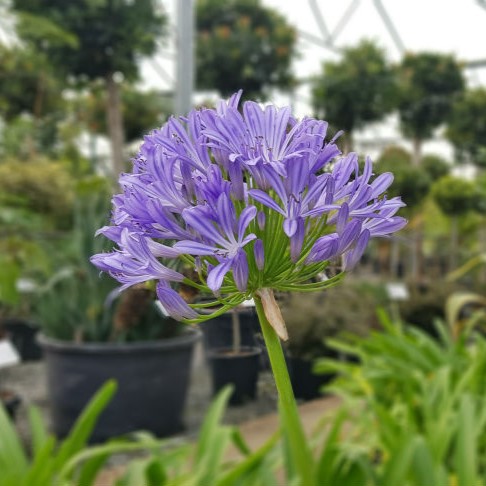Magnificent Agapanthus: Enhancing Your Yard's Appeal
Wiki Article
Releasing the Secret to Successful Agapanthus Growing: Advice for a Flourishing Yard
In the realm of gardening, cultivating agapanthus successfully needs a strategic method that includes numerous elements of plant care. By comprehending the nuances of agapanthus growing, one can develop an atmosphere where these plants grow and bloom abundantly.Planting Agapanthus: Finest Practices
When planting Agapanthus, correct dirt prep work is necessary for ensuring successful growth and advancement of these gorgeous blossoms. Agapanthus, commonly called Lily of the Nile or African lily, prospers in well-draining dirt with a somewhat acidic to neutral pH level - Agapanthus. Before growing, it is critical to modify hefty clay soils with raw material such as garden compost or peat moss to boost drainage and provide crucial nutrients for the plantsTo plant Agapanthus, choose an area that obtains complete sunshine to partial color, as this will promote healthy growth and plentiful flowering. Dig a hole twice the diameter of the plant's root sphere and put the Agapanthus at the exact same depth it was previously growing. Gently backfill the hole with dirt, weighing down strongly to remove any kind of air pockets around the origins.
Water the freshly grown Agapanthus thoroughly and remain to maintain the dirt uniformly moist, especially throughout the plant's energetic expanding season. Agapanthus. Using a well balanced plant food once a month can even more support the plant's development and blooming. By complying with these best practices for growing Agapanthus, you can produce a magnificent display screen of these exciting flowers in your garden
Perfect Soil Issues for Agapanthus
For optimum development and flowering success of Agapanthus plants, guaranteeing the dirt problems are optimal is essential. Agapanthus thrives in well-draining dirt with a somewhat acidic to neutral pH degree ranging from 6.0 to 7.0. This sort of dirt enables ample water drainage, avoiding waterlogging which can bring about root rot. To enhance dirt drain, consider including natural issue such as compost or peat moss when preparing the planting website. In addition, Agapanthus favors dirt that is rich in nutrients, so including a balanced fertilizer throughout the growing period can promote healthy and balanced development and vibrant blossoms.
Watering and Fertilizing Tips
To make sure healthy and balanced growth and dynamic blooms, correct watering and feeding strategies are crucial for effective Agapanthus important site growing. Agapanthus plants benefit from regular watering, especially during the expanding season.When it concerns fertilizing Agapanthus, a well balanced fertilizer with equivalent parts nitrogen, phosphorus, and potassium can be used in the springtime to promote healthy growth and flowering. Slow-release fertilizers are perfect for supplying nutrients progressively over a prolonged duration. Stay clear of over-fertilizing, as this can cause excessive foliage development at the expenditure of blooms.
Additionally, including natural matter like garden compost right into the soil can enhance nutrient levels and boost dirt structure, assisting in the overall wellness of the Agapanthus plants. By following these watering and feeding ideas, gardeners can guarantee their Agapanthus plants thrive and create stunning displays of blossoms.
Trimming and Deadheading Techniques
Correct trimming and deadheading methods play an essential function in keeping the health and looks of Agapanthus plants, matching the important techniques of watering and fertilizing for effective farming. Pruning Agapanthus includes getting rid of spent flower heads, dead or yellowing fallen leaves, and total shaping of the plant to promote far better growth. Deadheading, the process of eliminating discolored blossoms, not only improves the plant's appearance yet also motivates further flowering.When deadheading Agapanthus, it is suggested to snip off the flower stem at the base utilizing sharp, tidy shears. This procedure redirects the plant's power from seed manufacturing back into origin and vegetation growth, promoting a healthier and much more durable plant. Normal deadheading can extend the flowering duration of Agapanthus and prevent self-seeding, which can result in overcrowding.
In terms of pruning, Agapanthus normally take advantage of a light trim after flowering to clean up the plant and urge fresh development. Reducing back the invested blossom stems and getting rid of any Check This Out broken or dead vegetation aids maintain the plant's vigor and general look. Nonetheless, it is vital to stay clear of cutting into the crown of the plant, as this can compromise its wellness.

Protecting Agapanthus From Pests and Diseases
Carrying out efficient insect and illness management approaches is important to safeguarding the health and wellness and vigor of Agapanthus plants in cultivation. One usual bug that influences Agapanthus is the Agapanthus borer, a caterpillar that tunnels right into the plant, creating damage to the flowers and fallen leaves.In addition to parasites, Agapanthus are susceptible to diseases such as root rot and fungal leaf areas. By remaining vigilant and dealing with parasite and disease issues immediately, garden enthusiasts can assist their Agapanthus flourish and grow.

Verdict
Finally, effective growing of agapanthus requires correct planting strategies, perfect soil conditions, appropriate watering and fertilizing, normal pruning and deadheading, and protection from parasites and conditions. By adhering to these tricks and tips, gardeners can ensure a growing yard full of beautiful agapanthus blooms. Agapanthus. Bear in mind to keep regular treatment and interest to information to promote the health and durability of these sensational plantsWhen growing Agapanthus, correct dirt prep work is crucial for ensuring effective development and growth of these gorgeous flowers.Water the newly grown Agapanthus completely and continue to keep the dirt uniformly moist, especially during the plant's active expanding period.For ideal development and flowering success of Agapanthus plants, making certain the soil problems are suitable is vital. When growing image source or transplanting Agapanthus, make sure the dirt is well-prepared to provide the required foundation for the plants to develop themselves efficiently. One usual pest that affects Agapanthus is the Agapanthus borer, a caterpillar that tunnels right into the plant, creating damages to the flowers and fallen leaves.
Report this wiki page